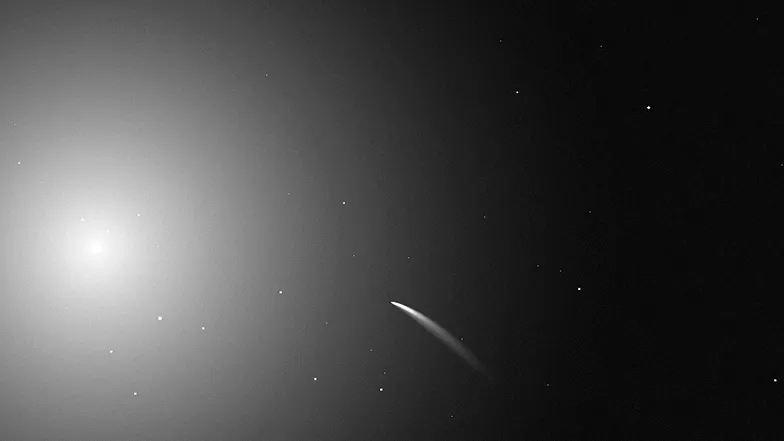
Get Ready! The Stunning G3 ATLAS Comet is Set to Dazzle the Skies – Could it Outshine Venus?
2025-01-09
Author: Jacques
Brace yourselves, celestial enthusiasts! The brilliant G3 ATLAS comet, also known as C/2024, is poised to reach its peak luminosity, expected to rival the brightness of Venus! This awe-inspiring cosmic spectacle has been intriguing astronomers and stargazers alike, as it prepares to make its much-anticipated appearance later this week.
The Discovery Journey
Discovered on April 5, 2024, by the Asteroid Terrestrial-impact Last Alert System (ATLAS) in Chile, G3 ATLAS was initially found while residing an astonishing 407 million miles from Earth. It began its journey as a faint object, hardly visible even to experienced skywatchers. Initial observations indicated it was among the dimmest celestial bodies, nearly 158,000 times fainter than the faintest star visible to the naked eye.
An Ancient Return
What makes G3 ATLAS even more special is its ancient origin. After recalculating its orbit, astronomers identified it as a "dynamically old comet," which suggests it has passed close to the sun at least once before in its long 160,000-year orbit. While comets from the Oort Cloud often break apart, the resilience shown by G3 ATLAS so far gives us hope for a breathtaking display in the coming days.
A Southern Delight
Sadly for our friends in the Northern Hemisphere, G3 ATLAS's current trajectory favors skywatchers down south. The comet's path has taken it through the constellations of Lupus, Scorpius, and Sagittarius, making it nearly inaccessible to those looking up from the northern skies.
However, there's good news on the horizon! As G3 ATLAS approaches its perihelion—the point in its orbit closest to the sun—its brightness has begun to surge, opening a fleeting window of opportunity for northern observers!
An Unexpected Brightness Spike
On January 2, 2025, G3 ATLAS exhibited a sudden outburst in brightness, raising eyebrows among seasoned comet watchers. Some experts feared this could indicate disintegration, but others believe it might just be a typical behavior of large comets. Renowned observers like John Bortle and Nick James have weighed in, suggesting the comet could survive this outburst and continue to shine.
How Bright Will It Shine?
Astronomers predict that G3 ATLAS may reach a maximum brightness of -3.2 on January 13, however, depending on various factors like forward scattering—the phenomenon that makes comets seem brighter—this could soar higher, potentially matching or surpassing Venus's radiance.
Daring predictions suggest magnitudes as low as -6 are conceivable, leading to the very real possibility that this comet could be seen by daylight under ideal conditions! But be warned—scanning the sky near sunrise or sunset must be done cautiously to avoid the sun’s damaging rays.
When and How to View G3 ATLAS
Mark your calendars! Northern Hemisphere observers have a narrow window from January 12 to 14 to capture this incredible sight. Best chances are on the mornings of January 12 and evenings of January 14, when G3 ATLAS will appear just above the sun—making binoculars essential for spotting.
Choose a location with an unobstructed view of the horizon, away from city lights. Observers should plan to start looking around 25 minutes before sunrise or 10 minutes after sunset for their best chance at seeing this celestial wonder.
The Safest Method to Enjoy the Show
While daytime viewing of G3 ATLAS could theoretically be possible, it's important to approach this with extreme caution. Using a telescope or binoculars at such moments can severely risk your eyesight. The best method to safely watch this comet during its close pass of the sun is through online platforms like the Solar and Heliospheric Observatory (SOHO), which will provide real-time imagery and updates.
The world eagerly anticipates the arrival of G3 ATLAS—will you be among those fortunate enough to witness the spectacle? Keep your eyes on the skies and prepare for a cosmic experience like no other! Don’t miss out on updates; they’ll be here as the comet draws near!









 Brasil (PT)
Brasil (PT)
 Canada (EN)
Canada (EN)
 Chile (ES)
Chile (ES)
 Česko (CS)
Česko (CS)
 대한민국 (KO)
대한민국 (KO)
 España (ES)
España (ES)
 France (FR)
France (FR)
 Hong Kong (EN)
Hong Kong (EN)
 Italia (IT)
Italia (IT)
 日本 (JA)
日本 (JA)
 Magyarország (HU)
Magyarország (HU)
 Norge (NO)
Norge (NO)
 Polska (PL)
Polska (PL)
 Schweiz (DE)
Schweiz (DE)
 Singapore (EN)
Singapore (EN)
 Sverige (SV)
Sverige (SV)
 Suomi (FI)
Suomi (FI)
 Türkiye (TR)
Türkiye (TR)
 الإمارات العربية المتحدة (AR)
الإمارات العربية المتحدة (AR)